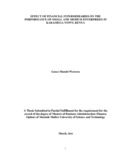EFFECT OF FINANCIAL INTERMEDIARIES ON THE PERFORMANCE OF SMALL AND MEDIUM ENTERPRISES IN KAKAMEGA TOWN, KENYA
Abstract
Financial intermediation is one of the most important activities to any business enterprise globally. The primary objective of any business enterprise in its existence being profit and wealth maximization. In view of this, the effect of financial intermediaries are of great importance to emerging economies like Kenya. The general objective of this study was to determine the effect of financial intermediaries on the performance of small and medium enterprises in Kakamega Town, Kenya. Specifically, the study determined the effect of liquidity on the performance of small and medium enterprises, determined the effect of risk diversification on the performance of small and medium enterprises, determined the effect of pool saving on the performance small and medium enterprises and determined the moderating effect of organizational factors on the relationship between role of financial intermediaries and performance of small and medium enterprise. The study adopted a descriptive survey research design. The target population comprised of 4,149 small and medium enterprises from which 415 were randomly selected from the stratified groups. The study used both primary and secondary data collection instruments. Primary instruments included the use of questionnaires and interview schedules. Secondary instruments involved information from the small and medium enterprises and financial institutions. A pilot study to test reliability and validity of the research instruments was carried out in Bungoma County which is a neighboring county. The results of pilot study enabled some modifications of the research instruments where necessary after discussions with the supervisors. Reliability of the instruments was tested through use of Cronbach’s Alpha coefficient of at least 0.70 which was acceptable implying that the instruments were reliable while the test -retest method was used to test validity. Descriptive statistics such as frequency, percentages, means and standard deviation were used to summarize the data and establish characteristics of the study population. Inferential statistics such as simple linear regression and correlation analysis were used to determine the relationship between the independent and dependent variable. The findings were presented using tables and charts. The study established that liquidity, risk diversification and pool savings have positive effect on the performance of small and medium enterprises. The results showed that 56.7% of small and medium enterprise performance can be explained by liquidity. 48.6% of small and medium enterprise performance can be explained by risk diversification and 53.4% of the performance can be explained by pool savings. It was therefore concluded liquidity greatly affected the performance of small and medium enterprises. The study thus recommends that organizations should aggressively engage in ensuring their business have enough cash cover, engage in different types of business to spread their risk, to actively engage in pool savings and to analysis the organizations factors since they have a positive moderating effect on the relationship between role of financial intermediaries and performance of small and medium enterprises. The outcome of this study contribute to existing pool of knowledge on embracing financial intermediaries by small and medium enterprises in enhancing their performance. To the management and policy makers, in decision regarding the regulation of Financial Intermediaries. Moreover, the findings of this study form a framework for further research in Kenya and the world in general by interested parties.

